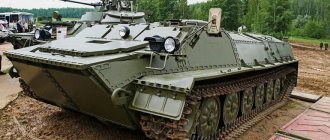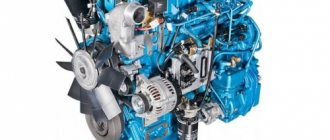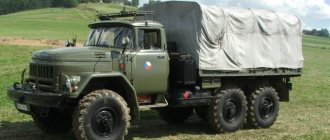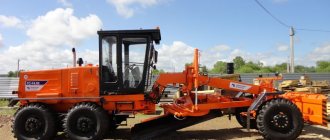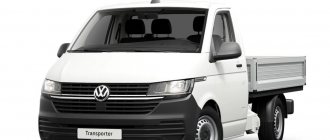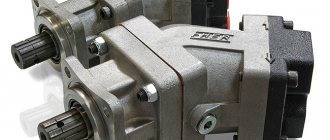The GAZ-71 tracked transporter is a truly unique and universal design. The vehicle can be used to transport cargo, personnel or tow trailers in off-road conditions. The sealed conveyor body allows you to cross water obstacles without any preparation of the machine.
The car was widely used in the northern regions, where it received a lot of nicknames - “Brute Dumb Force”, “Gasushka” or “Zhuzhik”. The GAZ-71 design had great potential for development and modernization. Currently, GAZ-3403 transporters are being produced, slightly different from their predecessor.
Transmission
Some technical data of the conveyor:
- The gearbox is four-speed, manual, synchronizers are in third and fourth gear, reverse gear is with a reduced gear ratio;
- transfer case of a two-shaft type, with two gears;
- main gear – bevel gears in an aluminum housing;
- cardan drive – shaft on needle bearings;
- dry clutches, multi-disc, 10 driving, 9 driven;
- copper-asbestos band brake mechanisms, drum diameter – 294 mm, pressure band width – 120 mm;
- Onboard transmissions are single-stage, with a cylindrical gear.
Caterpillars: Design and purpose
Later, a reinforced rubber-metal propulsion unit with a peripheral frame and two large support wheels was tested on a production GAZ-66 truck with an all-metal cab. The car used an original search transmission designed by engineer Boris Akimovich Dekhtyar with a centrally located transfer case and through-bevel main gears of both middle axles with cam limited-slip differentials, from which torque was redistributed to the outer axles.
Transmission and brakes
The design of the all-terrain vehicle uses a permanently closed, dry, single-disc damper clutch with a diaphragm pressure spring. Gearbox – mechanical, five-speed, three-way. The same is installed on the all-wheel drive off-road truck GAZ Sadko. Gear ratios: 1st speed: 6.555; 2nd: Z.9ZZ; Z-I: 2,Z76; 4th: 1.442; 5th: 1,O; reverse: 5.7Z5.
Cardan transmission is an open, 2-joint cardan shaft with crosspieces on needle-type bearings. Additional transmission – mechanical, 2-speed, 2-shaft. Gear ratios: O.96 and O.56. The main gear is single-stage, bevel, with spiral teeth. Gear ratio – 1.9.
Multi-disc onboard clutches are dry, with steel discs. There are ten drive disks, 9 driven disks, and fourteen pressure springs.
The service brakes of the snow and swamp-going vehicle are double band brakes, with parallel bands and floating pads. The width of the pad is 62 mm, and the outer diameter of the brake drum is 30 mm. Service brakes and their drive from control levers are used as parking (mountain) brakes. Final drives are single-stage, with spur gears; final drive ratio – 3.7.
The diesel fuel supply is controlled by a pedal and a handle; turning control - turning off the side clutches and braking the drive wheels using 2 control levers
The service brakes are controlled by braking the drive wheels using 2 control levers. The parking (mountain) brake is controlled by fixing the control levers in the braked state with pawls, which are driven by the buttons of the control levers.
All-terrain vehicle characteristics
GAZ 71 diesel has technical characteristics that distinguish it favorably from the previous GAZ 47 model. Let's consider the main ones.
The GAZ 71 engine has 8 cylinders. It runs on gasoline. It is a strong carburetor with a capacity of 115 horsepower. Volume – 4.25 l. The engine is part of a single system. It is built into the engine compartment. It also includes a gearbox, a single-plate dry clutch and an additional gear. The gearbox is mechanical, four-speed. It has five speeds - four forward and four reverse. The transfer case has two gears, inherited from the GAZ 66. The device also includes final drives and a double band brake system.
The chassis consists of the following components:
- support rollers. There are 12 of them in total;
- tracks covered with rubber. There are 6 of them on each side;
- driving wheels (2 pieces).
Hydraulic shock absorbers are installed on the rear guides and front rollers.
The body is an open steel heated cargo platform. In bad weather, you can additionally pull the awning to create a thermal and protective effect when transporting people. The all-terrain vehicle is designed for 12 seats. Two seats for the crew in a metal cabin and 10 seats with soft folding seats in the body for troops carrying people. For cases of transporting the wounded, the body is equipped with the necessary sanitary equipment.
The tightness of the cabin is ensured by a rubber seal along the edges of the doors. This is a guarantee of protection against dust and water. For air ventilation in the cabin there are two sealed hatches. It also provides thermal insulation, a heater, soft seats, and soundproofing. In general, the equipment of the all-terrain vehicle creates optimal comfort for people while driving. Behind the driver's seat, in “manual accessibility”, there is a battery hidden behind a metal plate. It can be easily removed, which is very convenient.
GAZ 71
Frame
At the heart of the GAZ-71 conveyor is a steel body welded from sheets of various thicknesses. The body is sealed, which allows the vehicle to overcome water obstacles without special training.
The body is divided into three sections:
- cabin;
- engine compartment;
- cargo platform.
The engine compartment is separated from the cabin and cargo part of the transporter by steel bulkheads. The bulkheads have removable hatches designed for servicing the power unit. A pump is installed in the engine compartment, designed to pump out liquid that enters when overcoming water barriers.
The GAZ-71 cabin is completely metal, equipped with two seats: for the driver and passenger.
Access to the cabin is through hinged side doors or through two hatches in the roof. The loading platform is made directly in the conveyor body. To facilitate unloading and loading, the upper part of the tailgate is hinged.
On the sides of the platform there are folding semi-soft seats. The platform is covered from above with a tarpaulin awning mounted on arches. To heat the internal volume of the cargo compartment, a separate liquid-type heater is used.
About the manufacturer
The caterpillar tractor plant in the city of Zavolzhye, Nizhny Novgorod region, was founded in 1949 as a mechanical repair plant for the repair of construction equipment: bulldozers, tractors, excavators and others.
During the construction of the Gorky hydroelectric power station, the enterprise mastered the production of metal structures needed for this construction; and during the construction and launch of a chemical plant in Dzerzhinsk - the production of high-pressure vessels.
When the active development of the fields of the Far North and Siberia began, the active development of the country's oil and gas complex, it was necessary, in conditions of complete roadlessness, extreme temperature changes, impassable swamps, to move a huge amount of cargo, to deliver teams of geologists, oil and gas workers to the place of work.
To solve these important problems, the plant launched the production of tracked transporters in 1967. The enterprise was also included in the Gorky Automobile Plant. The first model launched into mass production was the GAZ-71 (GT-SM) all-terrain vehicle. These first snow and swamp-going vehicles had a payload capacity of one ton and were also equipped with gasoline carburetor engines of the 3M3-66 model. On the GAZ-34039 they will be replaced by more economical diesel engines, well known from the “people's” MTZ-80/82 tractors.
Since 1993, the Zavolzhsky Crawler Tractor Plant has become a joint-stock company. At the next stage of its development, the company became part of the Special Equipment division of the GAZ Group, continuing the production of all-terrain vehicles for the Russian oil and gas industry. In 2012, a joint venture was established with the international engineering corporation Terex. The plant belongs to the Russian Machines holding.
In 2007, as part of the national project “Health”, the plant developed an all-terrain ambulance based on the GAZ-34039 snow and swamp-going vehicle. The special vehicle is fully equipped to carry out emergency treatment by a medical team, transport patients and monitor their condition.
In 2010, the company mastered the production of a new model of the GAZ-34039 tracked snow and swamp-going vehicle, which received the additional name “Irbis”. Distinctive features of this version of the all-terrain vehicle from the classic model are a voluminous monobody, a larger number of seats (12, including the driver), and a more comfortable interior. Another new product of the plant was a two-link tracked snow and swamp-going vehicle.
Areas of application of technology
In the 60s, with the development of hard-to-reach northern and Far Eastern territories, a need arose for fundamentally new equipment capable of moving off-road and operating in any climatic conditions. The new model was developed on the basis of the GAZ-47 tracked transporter, which was previously used for the needs of the army and geological exploration. The new car, called the GTSM all-terrain vehicle, was distinguished by:
- simplicity of design;
- economical service;
- high cross-country ability in climatic and road conditions of any complexity;
- possibility of use in the temperature range from minus 50 to plus 40 degrees;
- availability of spare parts.
GAZ-71
These qualities were decisive for the use of the GAZ-71 all-terrain vehicle:
- in support of geological exploration and scientific expeditions;
- evacuation of the wounded from the scene of military events or disasters;
- delivery of people and goods to hard-to-reach areas;
- for transportation of extra-heavy trailers – up to 2 tons;
- in the oil and gas industry;
- on hunting and fishing.
Price
Some GAZ 34039 models have long been discontinued, so they can only be purchased on the secondary market. New series of all-terrain vehicles are sold both directly on the manufacturer’s website and on other automotive sites. On average, the cost of a new GAZ 34039 33 will cost 3 million rubles, and the price of the Irbis model is 3.5 million. A used GAZ 34039 can be found for about one and a half million, and, of course, do not forget about trading. The final cost of the car will depend on its condition, mileage and additional equipment.
In conclusion, it must be said that Russia is a very large country with different climatic conditions, and most similar brands of cars quickly fail in cold regions. Thanks to special protective functions and high-quality equipment, the all-terrain vehicle performs many tasks and is widely used in many areas of production.
Technical specifications in numbers
- Overall dimensions: length - 5.72 m (6.28 m for the Irbis), width - 2.55 m, height - from 2 m to 2.89 m (depending on modification).
- Weight – 4.8 tons.
- Base (distance between the centers of the outer rollers) – 3600 mm.
- Track width (distance between the middle of the tracks) – 2.18 m.
- Ground clearance is the smallest, with a full load - 4OO mm.
- Height to the drive wheel axis – 64О mm.
- Height to towing device – 64О mm.
- Loading height of the body (without load) – from 0.92 m to 1.2 m (depending on modification).
- Turning radius – 2.2 m.
- The climbing angle to be overcome is 35 degrees.
- The lateral roll angle is 25 degrees.
- Load capacity – 1.2 tons.
- The maximum permissible towing trailer weight is 2 tons.
- Maximum speed – 60 km/h; when driving on water – 6 km/h.
- The capacity of the fuel tanks is 370 liters of diesel fuel.
- Operating diesel fuel consumption is from 45 to 100 liters per 100 km (depending on operating conditions).
- Specific ground pressure – O.214 kg/sq.cm.
Refill tanks
Consumable data on components and assemblies:
- main gasoline tanks with a total volume of 232.5 liters;
- reserve tank – 77.5 liters;
- cooling system – 30 liters;
- engine lubrication system - 9.5 liters;
- air filter oil bath – 0.55;
- gearbox housing volume – 3 liters;
- final drive housing volume – 3 liters;
- volume of final drive housings – 2.6 liters;
- roller hubs - 0.16 liters each;
- fan gear housing volume – 0.11 liters;
- The capacity of the clutch hydraulic system is 0.45 liters.
Main controls:
- rotary functions - alternate activation of side clutches and brakes on the drive rollers;
- activation of the mountain brake - clamps on the levers;
- gear change - floor lever;
- transfer case gear shift - floor lever;
- Clutch operation is a pedal on the left, equipped with a hydraulic drive.
Chassis parameters:
- drive wheel axle height – 620 mm;
- height of the towing unit axis – 620 mm;
- cargo compartment height – 1130 mm;
- maximum speed on the highway – 50 km/h;
- maximum speed on water – 6 km/h
Electrical appliances and mechanisms:
- mains voltage – 12 volts;
- generator brand G130-E1 DC, shunt, shielded, 28 amperes;
- battery – type 6-ST-68-EMZ;
- relay-regulator – type PP-129;
- ignition distributor - type P105 with centrifugal ignition timing adjustment and octane number corrector;
- standard two-blade windshield wiper;
- starter – type ST130-B, push-button activation.
User manual
Each lightweight tracked all-terrain vehicle was equipped with a “Care Instruction.” This document, which consisted of 120 pages, was reprinted several times.
The main part of the instructions, more than 80 pages, contains instructions for the maintenance and maintenance of various components and structural elements of the snow and swamp-going vehicle.
In particular, the document describes:
- The engine with all the systems that support it (ignition, power, lubrication, exhaust and cooling);
- Transmission, consisting of a gearbox, clutch, transfer case and driveshaft;
- Chassis and control drive. The design of final drives, drive and guide wheels, idler, road wheels, turning mechanism and track chain is separately specified;
- Electrical equipment GAZ-47;
- Machine body.
In addition, the document contains instructions on the use of auxiliary equipment - a life jacket, a lever-plunger syringe (necessary when performing lubrication), a jack and a refueling device.
Only 10 pages of instructions are devoted to directly driving a tracked transporter, and recommendations are given for overcoming typical obstacles, including water obstacles. The procedure for using hydrodynamic casings and the “swimming” movement are described separately.
Operation of the GAZ-47 all-terrain vehicle in “summer” conditions
Operating a tracked all-terrain vehicle
The GAZ 71 crawler transporter appeared in 1968 and was named GT-SM. The abbreviation stood for “modernized tracked snow and swamp-going vehicle.” Over the almost 20-year history of its production (1968 - 1985), it has become a real legend, and the technical characteristics of this special vehicle allow it to be used in extremely difficult northern conditions to this day. It’s not for nothing that they say that Soviet technology is “indestructible.” The simple design of the GAZ 71, excellent all-terrain qualities and endurance - these are the main advantages of this miracle transport.
The main purpose of a caterpillar tractor is to transport people and various cargoes of national economic importance on all types of roads and off-roads, in virgin and northern regions. The equipment was used for transporting personnel of military units, servicing expeditions in difficult areas, for evacuating the wounded, for towing trailers whose weight does not exceed 2 tons, etc.
This brainchild of Nizhny Novgorod automakers is not immune to the most extreme conditions, because it is equipped with means of self-extrication if it gets stuck. The GAZ 71 all-terrain vehicle confidently overcomes snow debris, impassable swamps, desert areas, fords up to 1.2 m deep... And even floats. Perhaps it’s worth talking about this unique feature of the machine in more detail. Of course, you can’t make boat trips on it, but it will be able to cross a river up to one and a half kilometers wide. The car floats due to the rotation of the tracks, which are driven by the final drive, and the speed in the water reaches 5-6 km/h.
Naturally, before launching the equipment, the equipment is prepared: standard quick-release hydrodynamic casings are installed - they improve maneuverability and increase speed. GAZ 71 can rise from the water to the shore along a gentle slope with an inclination angle of no more than 20°. If you approach a steep bank with its side, there is a high probability that the all-terrain vehicle will tilt and flooding will occur over the side. There is practically no need to worry about the car crossing a calm river, however, you should be careful when crossing water obstacles with a fast current. There is a risk that the vehicle will spin and even flood. The main reason for this situation is the significant area of its underwater surface.
In general, despite its substantial dimensions - 5,390 x 2,585 x 1,740 mm and its apparent clumsiness, the tracked all-terrain vehicle maneuvers well in turns and develops a decent speed. On good roads, the speed of the GAZ 71 is 50 km/h, which is much higher than that of its predecessor, the GAZ-47. The speed when driving through swampy areas is low - 12-18 km/h. The machine can cross virgin snow meter deep at speeds of up to 17 km/h.
It would seem that everything is fine... But fuel consumption leaves much to be desired. When driving at maximum speed or on heavy off-road conditions, this figure reaches 150 liters per 100 km. Average fuel consumption is slightly lower - 90 -100 l / 100 km, but still quite a lot. In order to provide the “gluttonous” tracked transporter with an optimal power reserve, the designers equipped it with four fuel tanks. The capacity of the three main ones is 232.5 liters, the additional one is 77.5 liters. This fuel reserve is enough for 400 km of travel. Fuel tanks are located on the sides, on the wings of the platform.
Control
To control the GAZ-71 conveyor, a system of levers and pedals is used. The pedal drive has a throttle valve and a clutch. Switching speeds in the gearbox and transfer gearbox is carried out by separate levers. The rotation is performed by disabling the side clutch clutches, the shutdown drive is carried out using levers.
To control various equipment, buttons and toggle switches located on the instrument panel are used.
GAZ-47 tracked snow and swamp-going vehicle 1954 - 1967
The GAZ-47 all-terrain vehicle is the first post-war tracked transporter. Factory designation: GAZ-47 (GT-S - Crawler Transporter - Snow and swamp-going vehicle). The floating all-terrain vehicle is designed to operate in particularly difficult road and climatic conditions for both civilian and military use. Became the basis for the development of the GAZ-71 (GT-SM).
photo GAZ-47
The GAZ-47 all-terrain vehicle is a cross-country tracked vehicle designed for transporting goods and people in off-road conditions in the northern regions of the country, for towing trailers, as well as for use in geological surveys, in the construction and maintenance of oil and gas pipelines, power and communication lines, search and rescue operations and other needs of the army and the national economy.
The design features of the GAZ-47 all-terrain vehicle include the front location of the engine compartment along with transmission units, as well as the front location of the drive wheels. The GAZ-47 had a welded all-metal body, consisting of an engine compartment, a closed two-door cabin and an open cargo platform with a removable awning. The car was equipped with a gasoline engine with a capacity of 74 horsepower. The GAZ-47 chassis consisted of five rubberized road wheels, a caterpillar track and a drive wheel on each side of the vehicle. The rear (fifth) road wheels are also guide wheels.
The designers of the new GAZ reduced the specific pressure of the all-terrain vehicle on the soil due to the expanded tracks (up to 30 cm). Thus, for a standard tank, the pressure on the soil reaches 0.95-1.1 kg/cm², and for a Gorky all-terrain vehicle weighing 3.65 tons and carrying capacity of 1 ton it did not exceed 0.2 kg/cm², which made it possible to move through deep snowdrifts .
The GT-S could move through calm water into a ford of up to 1.2 m for a duration of about 1.5 km, move by swimming without additional preparation, the speed of movement through the water was regulated by the operation of the tracks. When creating modified versions, they tried to install cylindrical metal augers-floats instead of tracks, which were driven by the power unit. This modernization made it possible to reach a speed of movement on water of up to 20 km/h, but transportation over a solid area was impossible, which limited the functional properties of the equipment.
Bottom line
The GAZ-71 car transporter, which today can only be bought in used condition, is a true legend of the Soviet automobile industry. Its price remains constantly high, but finding such a car is not so easy; we could not find any messages about the sale of such cars on thematic Internet sites.
Despite the fact that the production of the model ended in the 85th year of the last century, it is still actively used in various industries and in the national economy, especially popular in the North, in hard-to-reach places that are inaccessible by other means.
GAZ-34039 "Irbis"
A further step in the evolution of the all-terrain vehicle was the GAZ-34039 “Irbis” model, first presented in Nizhny Tagil at the Sixth International Exhibition of Technical Equipment for Defense and Security “Defense and Protection-2O1O”, and mass production began in 2O11. These special vehicles are used in geological exploration expeditions, in the construction and maintenance of oil and gas pipelines, power and communication lines, and railway tracks in the harsh natural and climatic conditions of the Far North, Siberia and the Far East.
The classic all-terrain platform GAZ-34039 is used to produce the Irbis. However, a completely different superstructure is installed on it - a plastic cabin from an ekranoplan, developed by. This new model features improved driver's seat ergonomics, improved visibility, a more modern instrument panel and an additional interior heater.
An important change is a different layout of the power plant, in which the engine is hooded inside the cabin. This greatly facilitates its maintenance, especially in winter frosts.
“Irbis” also offers a variety of design options: fire truck, drilling rig, cargo and passenger version, residential module, and so on.
Unlike the Soviet versions of this all-terrain vehicle, the Irbis is distinguished by such important features as a voluminous monobody and the most comfortable passenger compartment for this type of special equipment. Thermal and noise insulation of the interior of the Irbis all-terrain vehicle is made using modern materials.
The all-terrain vehicle is equipped with a box-section bumper (in the frontal part of the all-terrain vehicle); Windshield protection has been completed. The body of the all-terrain vehicle is painted in non-standard colors with heat-resistant paint.
Additional equipment of the GAZ-34039 Irbis snow and swamp-going vehicle includes: an electric winch with a force of at least 6.8 tons; seat belts for all passengers; 2 fire extinguishers type 0U-2; two boxes for tools and equipment on the sides of the all-terrain vehicle; two shelves inside the all-terrain vehicle; set of entrenching tools: hand chainsaw; ax-hoes, shovels, incendiary devices, forest backpack fire extinguishers, sprayers-blowers, gas and smoke protection kits, first aid kits; tourist tents and sleeping bags.
Also on the list of options is a Dometric B2600-1 air conditioner, with roof installation; remote diesel generator; Flashing Light; sleeping places; table; two wardrobes; luggage racks and compartments; intercom between the driver's cabin and the passenger module; refrigerator with a volume of 50 l; microwave; combined interior lighting, with ceiling lamps and sconces; 24V and 220V sockets; microwave; voltage converter 24-220V; telematic module of the GLONASS system.
A ladder is built into the side of the cargo platform to ensure independent boarding (disembarkation) of passengers; An additional luggage rack is located on the roof. The OK-1 lighting complex has a luminous flux power of at least 1000 W. There is an emergency gas analyzer in the cabin and windshield branch cutters;
Army modification
The armored tracked all-terrain vehicle (armor thickness - 6 mm) GAZ-71 is airborne, mobile, highly maneuverable, has minimal dimensions, and is ideally suited for use in military conditions. The conveyor has only one relative disadvantage: its tracks wear out quickly, and individual tracks have to be replaced. Otherwise, the car is considered technically advanced; GAZ-71 spare parts are not often required.
The cabin has two seats - for the driver and the officer accompanying the vehicle. The body can accommodate 10 personnel.
The transporter body is not armored underneath and is quite vulnerable, but the vehicle was not created for offensive combat operations, but only as a reliable cargo carrier in off-road conditions.
Description of the design of the all-terrain vehicle GAZ-34039
The chassis consists of twelve road wheels, two idler wheels, two drive wheels, which are located in the front of the all-terrain vehicle, and two tracks. There are two types of tracks: with an open hinge and a tracked propulsion resource of 6 thousand kilometers; as well as with a rubber-metal hinge and a tracked propulsion resource of 12 thousand kilometers. The suspension is independent, torsion bar, with a significant angle of attack of the tracks both front and rear.
The number of road wheels is 12 (six on each side). The torsion bars are cylindrical, with splined heads at the ends. Their length is 0.99 m. The outer diameter of the working part of the track roller torsion bars is 31 mm. Track rollers – single, with rubber-coated rims; outer diameter 7OO mm, rim width 85 mm. The drive wheels are double-crowned, pinion geared, located in the front part of the body. Number of teeth – 1Z.
The guide wheels are suspended, single, with rubber-coated rims. The outer diameter is 54О mm, the rim width is also 85 mm. The caterpillars are small-linked, consisting of 92 links each. The width of the caterpillar link is 390 mm, the pitch of the caterpillar link is 128 mm. The caterpillar fingers with a rubber-metal hinge are steel, rubber-coated, and lockable due to the pressing force. Track fingers with an open hinge are borated, HDTV hardened, with a diameter of 15.5 mm. They are prevented from falling out by spring rings.
Shock absorbers – hydraulic, telescopic, double-acting. They are installed on the front and rear road wheels. There are four shock absorbers in total.
Rollers
The GAZ-71 conveyor is equipped with six steel road wheels with a diameter of 700 mm with external rubber shock absorption. The rear rollers serve as idler wheels. The rollers are mounted on steel balancers.
The balancer suspension is torsion bar, supplemented with hydraulic shock absorbers. Telescopic shock absorber cartridges are installed on the balancers of the front rollers and idler wheels. The drive wheels are located at the front. The ring gear is equipped with 12 teeth, the unit is removable and interchangeable.
Engine GAZ-34039
The GAZ-34039 snow and swamp-going vehicles are equipped with D-245.12S turbocharged diesel engines produced by the Minsk Motor Plant. These are four-cylinder in-line diesel engines with a displacement of 4750 cm³ and a power of 81 kW (110.2 hp), achieved at 2400 rpm. The maximum torque of this motor is 352 N•m and is achieved at a rotation speed of 1300-1700 rpm. The specific consumption of diesel fuel is around 218 g/kW•hour. Direct fuel injection, liquid cooling system.
The D-245.12S engine lubrication system is combined: under pressure and splashing. The oil pump is single-section, gear type. Oil filter – FM009-1012005, non-separable, replaceable. Crankcase ventilation is open type (breather).
The engine is equipped with a pre-heater that helps start the engine even at extremely low air temperatures.
The new GAZ-34039 Irbis all-terrain vehicles use a different engine modification - D245.7E2. With the same displacement of 4.75 liters, this power unit has a power of 122 hp at 3800 rpm. The maximum torque is 423 N•m, at a rotation speed of 1500 rpm.
